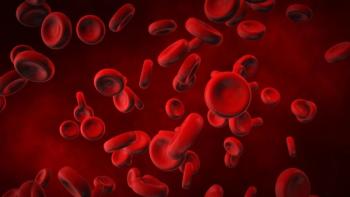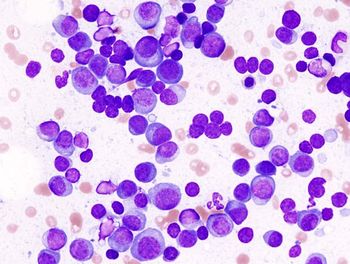
Adding Daratumumab to SOC Delays Progression in Advanced Multiple Myeloma
Adding daratumumab to either of two standard-of-care treatment regimens induces rapid, deep, and durable responses and improves progression-free survival in patients with relapsed/refractory multiple myeloma, confirm updated findings from the open-label phase III POLLUX and CASTOR trials.
Adding daratumumab to either of two standard-of-care (SOC) treatment regimens induces rapid, deep, and durable responses and improves progression-free survival (PFS) in patients with relapsed/refractory multiple myeloma, confirm updated findings from the open-label phase III POLLUX and CASTOR trials, presented at the 59th American Society of Hematology Annual Meeting and Exposition, held December 9–12 in Atlanta.
The POLLUX (
Daratumumab is a human IgGκ monoclonal antibody that targets CD38, which are uniformly overexpressed on multiple myeloma cells. It has both direct anti–tumor cell and immunomodulatory mechanisms of action.
Updated POLLUX Findings
“Patients who receive DRd demonstrated longer time to next therapy and responded more favorably to subsequent therapy as evidenced by prolonged PFS,” said Meletios A. Dimopoulos, MD, of the National and Kapodistrian University of Athens, Athens, Greece. “Importantly, the favorable safety profile was maintained with longer follow-up. These data support the addition of daratumumab to [SOC] regimens in relapsed and refractory multiple myeloma.”
The findings imply continued clinical benefit from prior daratumumab. “This is one of the best [PFS] rates recorded,” Dr. Dimopoulos said. Longer PFS was associated with MRD negativity and deeper responses, which were more common on DRd.
MRD negativity was achieved more rapidly with DRd and climbed over time, whereas time to MRD negativity for lenalidomide and dexamethasone without daratumumab climbed slowly and plateaued early.
The median duration of treatment was 30.4 months for DRd vs 16 months for lenalidomide and dexamethasone alone.
The safety profile was also unchanged with longer follow-up, Dr. Dimopoulos said. No difference was seen in treatment discontinuation due to treatment-emergent adverse events (13% in each study arm). Thirty-nine percent of patients in the DRd arm and 26% in the no-daratumumab arm experienced grade 3 or 4 infections.
The 30-month PFS was 73% (median PFS, not reached) in the DRd arm compared with 58% (median PFS, 32.3 months) for patients in the no-daratumumab group (hazard ratio [HR], 0.51; 95% CI, 0.38–0.67; P < .0001).
The median time to next therapy was not reached for patients receiving daratumumab and was 22.3 months without daratumumab (HR, 0.37; 95% CI, 0.29–0.48; P < .0001). More than half of DRd patients have not yet started a subsequent treatment strategy, Dr. Dimopoulos noted. “DRd does not negatively impact outcomes of subsequent therapy.”
Updated CASTOR Findings
In a poster presentation, Suzanne Lentzsch, MD, PhD, of Columbia University Medical Center in New York, and colleagues presented updated findings for the CASTOR trial, which added daratumumab to bortezomib and dexamethasone.
“Patients continue to benefit from prior daratumumab treatment,” they reported, as demonstrated by a significant PFS benefit in the intention-to-treat and subgroup populations. “Patients with deep responses and those with one prior line of therapy most benefitted.”
The updated, 24-month PFS for the intention-to-treat study population was not reached, compared with 20.7 months for the no-daratumumab group (HR, 0.47; 95% CI, 0.36–0.63; P < .0001). A subgroup analysis found that patients with one prior line of therapy also benefitted (HR, 0.32; 95% CI, 0.20–0.51; P < .0001), as did patients with high cytogenetic risk (HR, 0.44; 95% CI, 0.23–0.86; P = .013) and patients previously treated with bortezomib (29.9 vs 18.6 months; HR, 0.52; 95% CI, 0.37–0.72; P < .0001).
Patients with lenalidomide-refractory disease also benefitted, a subgroup analysis showed (25.3 vs 13.5 months; HR, 0.52; 95% CI, 0.33–0.83; P = .0050).
Responses were durable among responders who received daratumumab monotherapy maintenance therapy. The findings demonstrate prolonged benefit when daratumumab is added to a SOC regimen in relapsed or refractory multiple myeloma, the authors concluded. OS data remain immature for CASTOR.
Newsletter
Stay up to date on recent advances in the multidisciplinary approach to cancer.


















































































